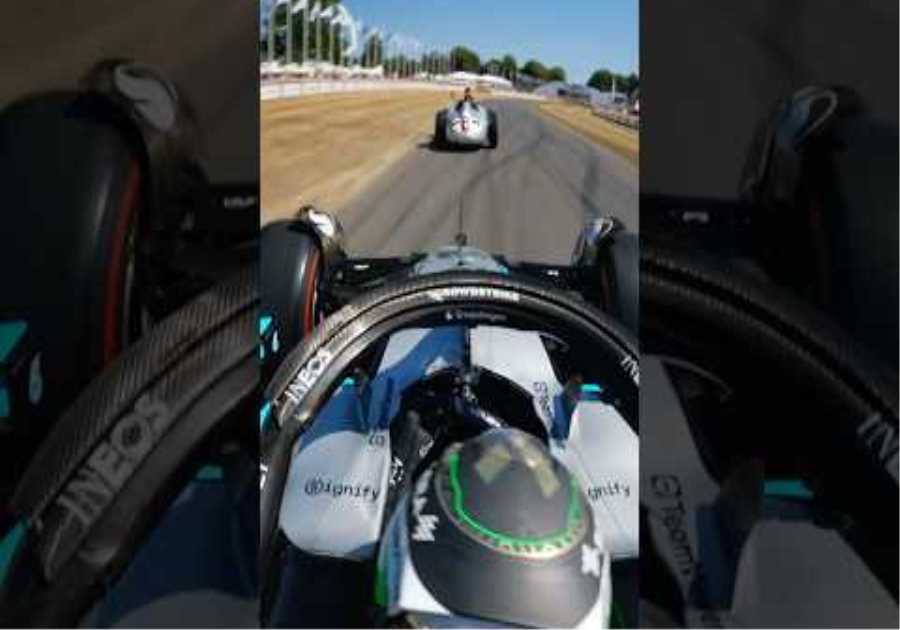
story
Suicide doors date back to the early 20th century, in the early years of the automobile. }
Although manufacturers by this time had already started experimenting with the design, early automobiles still looked very much like horse-drawn carriages, minus the horse, of course. At the beginning of the 20th century, cars were still a novelty and too expensive for the general public. As such, carriage designers often turned to architects to come up with a design fit for a high-end product.
French style doors
A design element that features heavily in architecture is the French-style doors, which are essentially two adjacent doors opening outward from the center. To this day French doors are considered some of the most elegant and stylish, as well as a symbol of wealth, which is why carriage builders have adopted them for use in automobiles.
At the beginning of the 20th century, cars were still referred to as “carriages without horses”. French-style doors transitioned to the automobile and slowly took the name carriage doors, as the Lincoln Continental suicide doors are known, to this day.
Safety risks of suicide doors
As the automobile evolved, it became increasingly mass-produced and widely available, eventually replacing the horse-drawn carriage entirely. This was accompanied by more horsepower, which also increased the risk of accidents and injuries. The 1960s is best known for the horsepower wars and the muscle cars (some would say they’re one and the same), where cars were capable of immense power but many still didn’t have seat belts.
In 1965, a man named Ralph Nader, concerned about road safety, published a book called Unsafe at Any Speed. While some associate the book with describing the rear-engine Chevrolet Corvair as a terrible vehicle, it actually listed every unsafe aspect of American vehicles while blaming automakers for an unwillingness to standardize on safety features.
Among the many design flaws that compromise safety, Nader’s book lists the suicide doors. Because they are rear-hinged, suicide doors pose a potential risk to occupants and pedestrians. Since suicide doors were popular in times when cars did not have seat belts, the likelihood of falling out when opening a suicide door was much greater.
Another security risk is opening a suicide door without being aware of the surroundings. If another vehicle hits a rear hinged door while someone is boarding or exiting the vehicle offside, the suicide door can hit the passenger or even pinch it between the door and the body of the car, potentially causing fatal injury.
Suicide cars were also unsafe for pedestrians. A passenger exiting a car through a suicide door has a greater chance of hitting a pedestrian standing near the outside of the car, possibly pushing them onto a busy road and causing an accident. On the plus side, people who own cars with suicide doors often have chauffeurs open the door for them.
Why are they called suicide doors?
It’s a pretty extreme nickname, especially when compared to butterfly doors – another distinctive type of door, due to the way they open. The name “suicide doors” comes from the many design flaws that can potentially cause harm to passengers or bystanders. In theory, at high speeds, a poorly closed suicide door can open and drop a person out. If the headwind is too strong, it can even tear the door off the car’s body and send it into another car’s windshield. In fact, a 1969 consumer report addressed a similar problem with the Subaru 360.
Benefits of suicide doors
Despite the name and potential dangers, suicide doors aren’t all bad. For one thing, they allow much easier access to the vehicle interior. Suicide doors also allow chauffeurs easier access to the rear door handle, allowing them to open the rear door without exiting the vehicle.
In many cases, suicide doors mean more interior space. Due to the linkage at the rear, the B-pillar can be dispensed with in many cars. Of course, these days a B-pillar is vital for safety, which is why you won’t see a modern suicide door car without one.
Another plus of suicide doors is that they make it easier to install a child seat due to the easier access they provide. Technically, this makes suicide cars more practical for families with babies.
suicide doors today
Suicide doors may have been popular once, but they are far from mainstream today, unlike some other types, like the butterfly doors, which are mostly found on supercars. For a while the design element died out, but some manufacturers brought suicide doors back into some of their models, with one manufacturer even using them in all of their models. There are a few 21st century cars that have suicide doors.
Rolls Royce – All current models
Rolls Royce is known for its ultra-luxurious British cars even after it was acquired by BMW in 2003. Currently, all Rolls Royce models have suicide doors. This includes the two-door ones like the Rolls Royce Wraith, Dawn and all its other derivatives. It is currently the only car company that offers a full line of suicidal door cars. It all started in 2003 with the Rolls Royce Phantom.
Mazda RX-8
A few years ago, the rotary-driven RX-8 never quite managed to reach the cult status of its predecessor, the RX-7. Regardless, it tried to offer a bit more practicality by featuring small rear suicide doors. The only difference here was that you had to open the full size front doors first, revealing the hidden door handles for the small suicide doors. Similar design suicide doors were also introduced on the Mazda MX-30 – the Japanese brand’s first electric vehicle. Both Mazda models have no B-pillar.
Lincoln Continental
Lincoln Continental suicide doors have actually been referred to by Lincoln, as is their original name, as carriage doors since suicide doors first appeared in the automobile. Just as stylish as the classic models, the latest generation Lincoln Continental suicide doors certainly don’t look out of place even on a 2020 car.
Toyota FJ Cruiser
The Toyota FJ Cruiser is a highly capable and desirable retro-futuristic SUV, styled after the original 1960 Toyota Land Cruiser 40 Series. Unlike the classic, the modern interpretation features the quirky suicide doors, but you have to open the front ones first to open the rear ones, just like the Mazda RX-8 and MX-30. Still, the rear-hinged doors allow easier access to the second row without having to fold down the front seats like in a sports car. Like the Mazda RX-8 and MX-30, the FJ Cruiser has no B-pillar.
BMW i3
BMW also offers suicide doors on one of its models. While the i8, as befits a sports car, has butterfly doors, the i3 has rear suicide doors for easier access to the rear seats. As with most of the other vehicles we’ve mentioned, you have to open the front doors first and it doesn’t have a B-pillar. While the i8’s butterfly doors are cooler, the i3’s suicide doors actually offer more functionality.
questions and answers
Which Tesla has butterfly doors?
The Tesla Model X features what the company calls Falcon doors. Although some refer to them as butterfly doors, the way they open is actually more like gullwing doors, such as those on a Mercedes 300SL or, more recently, the Mercedes SLS AMG.
What types of doors are there on a car?
To date, 9 different types of car doors have been classified – conventional (most vehicles), scissor doors (“Lambo”), suicide doors, swan doors, butterfly doors, sliding doors, pocket doors, cabin doors, gullwing doors, and double leaf doors.
What are the doors of a car called?
The door of a car does not have a specific name. It is commonly referred to as a car door. Depending on where it is on the car, it could be a front, back or liftgate, also known as a trunk lid or tailgate (when it opens with the rear window – hatchback style).
What is the difference between butterfly doors and suicide doors?
Butterfly doors open up and out, while suicide doors are rear-hinged and open opposite a conventional door (which most cars have). Cars with butterfly doors are McLaren P1, McLaren F1, Toyota GT-One, Ferrari Enzo, Saleen S7 and others. Cars with suicide doors include Mazda RX-8, Lincoln Continental, Rolls Royce Wraith, Rolls Royce Phantom, Mazda RX-30, BMW i3, Toyota FJ Cruiser and others.
What is the difference between scissor doors and butterfly doors?
Scissor doors swing vertically upwards, while butterfly doors swing upwards and outwards at the same time. Scissor doors have many names, such as B. Lambo doors, switchback doors, gullwing doors and others. Most Lamborghini models feature scissor doors. Butterfly doors can be seen on all McLaren models currently for sale.
Why are they called butterfly doors?
Butterfly doors get their nickname from the way they open, which resembles a butterfly’s wings.
Can every car have butterfly doors?
Theoretically yes. While very few cars come with butterfly doors from the factory, conversion kits can be found or made.
What are suicide doors?
Suicide doors are doors that are rear-hinged and open opposite, compared to the traditional doors found on most cars.
Are suicide doors illegal?
Despite the controversial name, no. However, if they are not standard on your car, remember that certain countries may have laws against aftermarket modifications that extend to the doors.
How to install suicide doors?
Usually many changes are required, sometimes irreversible. Essentially you’ll need to move from front hinges to rear hinges, but that’s just the start as the door opening mechanism will also need to be relocated.
Why did old car doors open backwards?
Suicide doors are a French door-inspired design element found in many expensive homes. To this day, it remains a symbol of wealth and style. Since cars were only available to the wealthy, suicide doors became effectively the automotive equivalent of French doors.
What year did they stop making suicide doors on cars?
In the late 1960s, suicide doors were banned from automobile production as their design was recognized as potentially life threatening.






